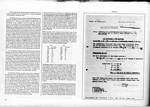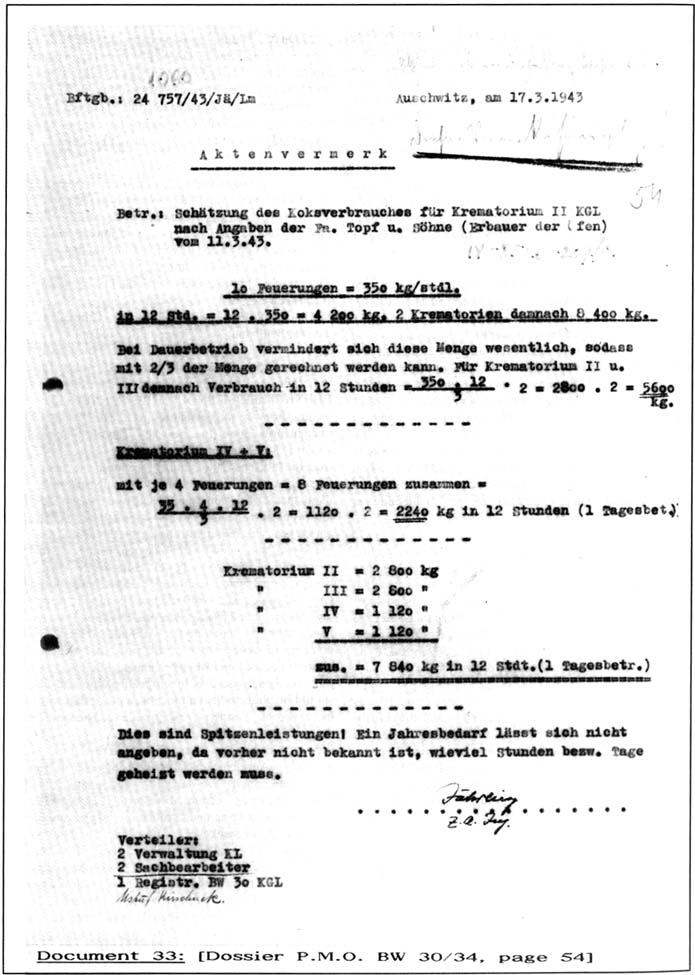|
|
 |
 |
AUSCHWITZ:
Technique
and Operation
of
the Gas Chambers © | |
|
| |
 |
Back |
 |
Contents |
Page 224 |
 |
Home
Page |
Forward |
 |
| |
On 8th and 9th March, and March, Messing continued working 8
hours a day on the air extraction system of Leichenkeller 2, which
he designated “Auskleidekeller / undressing cellar”.
On
10th March, Messing worked for SIXTEEN HOURS straight, testing the
ventilation and air extraction systems of Leichenkeller 1 of
Krematorium II. These tests were intended to determine first the
effectiveness of the ventilation, then the waiting time necessary
between the introduction of the toxic gas and the opening of the
gas-tight door. The ventilation system of Leichenkeller 1 had
initially been designed for a morgue, with the fresh air
entering near the ceiling and the cold unhealthy air being drawing
out near the floor. Its use as a gas chamber really required the
reverse situation, with fresh air coming in near the floor and warm
air saturated with hydrocyanic gas being drawn out near the ceiling.
But the SS and Prüfer chose to maintain the original “morgue”
ventilation system in the gas chamber, hoping that it would be
efficient enough. The famous ten gas detectors, ordered through
Topf, were used to check this point, and probably also to cheek the
gas-tightness of the door sealing. It would appear that by the
evening it was established that the ventilation was almost
satisfactory, and that 20 to 30 minutes appeared sufficient to bring
the HCN concentration down to a reasonable level so that the door
could be opened and the future (corpse) “extraction commando” could
start its work in reasonable safety. In the author’s opinion, it was
still necessary to make some adjustments and modifications before
the optimal result was achieved.
On 11th March, principal
engineer Schulze [written Schultze] obtained from Bischoff a
certificate of presence at Auschwitz for 1st to 12th March, having
had to remain on site, in accordance with the contract, for the
installation of the ventilation and air extraction systems [of
Leichenkeller 1] of Krematorium II. This certificate states that the
ventilation of the gas chamber was to come into service in the
evening of 12th March. In fact it was not ready until the following
evening. The same day, Jährling sent the Camp Kommandantur
Administration three copies of the “Betriebsanweisung / Operating
instructions” for the 3 muffle furnaces of Krematorium II
[Document 31] supplied by Messrs Topf and being no different
from those provided for the third double-muffle furnace [known as
the “new furnace” of Kr I]. Two copies were displayed in the furnace
room [one of them being “recuperated” by Dr Miklos Nyiszli in
November 1944] and the other was filed.
On 12th March,
Messing was again at work on the ventilation of the “undressing
cellar” [Leichenkeller 2] of Krematorium II, probably waiting for
parts to he manufactured locally or the completion of other work
before finishing off the ventilation system of Leichenkeller 1. The
same day, Jährling calculated the theoretical coke consumption to
allow for the four Krematorien and obtained a figure of 8,264 kg for
12 hours of operation (it being implied that the furnaces would
operate 12 hours s day) [Document 32]. 321. His calculation
contained TWO ERRORS [!], the first concerning the consumption of
Krematorien IV and V, and the second an error in addition (a mistake
of 800 kg — he should have obtained a total of 7,464, not 8,264).
Bischoff initialed the incorrect result without question. The
figures were considered to be maximum consumption (“Spitzleistungen
/ Peak production”). Jährling admitted he could not determine annual
consumption because it was not known how many hours a day the
furnaces world be working. |
| |
[The correct theoretical consumption was calculated by
Jährling on 17th March [Document 33], giving a figure of 7,840
kg of coke for the four Krematorien in 12 hours of activity PER
DAY. Very proud of himself for having achieved a “good”
result, Jährling signed it and added his status “Z.a. Ing./
Civilian employee, Engineer” a detail that should have been
omitted considering his arithmetical abilities! The result of 12th
March, instead of being cancelled and destroyed, was filed with
that of 17th, on which Kirschneck nevertheless wrote “dieser
Vermerk is richtig! / this note is correct!”. While it might be
thought that these calculations were the result of incompetence
and irrealism, this is not the case and the theoretical result,
apparently very approximate, turns out quite accurate when
compared with another PMO file.
PMO microfilm 12,012
contains the coke delivery notes for the Krematorien (without
distinguishing between them) from 16th February 1942 to 25th
October 1943, a period in which Krematorium I was the only one in
operation for the first thirteen months, followed by the
completion and bringing into service (between 22nd March and 25th
June 1943) of the four Birkenau Krematorien and the abandonment of
the cold “old Krematorium” at the Stammlager. The some two hundred
and forty delivery notes preserved make it possible to determine
coke requirements month by month: |
| |
| |
1942 |
|
1943 |
|
| |
Feb
(from 16th only) |
22 tons |
|
Jan |
23 tons |
|
| Feb |
40 |
| |
Mar |
39 |
|
Mar |
144.5 |
|
| |
Apr |
39 |
|
Apr |
60 |
|
| |
May |
32 |
|
May |
95 |
|
| |
Jun |
29.5 |
|
Jun |
61 |
|
| |
Jul |
16.5 |
|
Jul |
67 |
|
| |
Aug |
31.5 |
|
Aug |
71 |
|
| |
Sep |
52 |
|
Sep |
61 |
|
| |
Oct |
15 |
|
Oct |
82 |
|
| |
Nov |
17 |
|
|
|
|
| |
Dec |
39 |
|
|
|
|
| |
Disregarding February 1942 (incomplete data) and
stopping at the end of February 1943, we can determine the average
monthly coke consumption of Krematorium I over a twelve month
period: 31.1 tons. As Krematorium I had 3 double muffle furnaces,
one muffle required approximately 5.2 tons of coke per month. The
note of 17th March 43 establishes a theoretical daily consumption
of 7.84 tons for the four new Krematorien with a total of 46
muffles, which also gives a monthly consumption of 5.2 tons of
coke per muffle. These two concordant figures:, coining from
different sources, show that the theoretically calculated figures
of the note of 17th March can be considered valid and that in PMO
microfilm 12,012 the delivery notes for the supply of coke to
Krematorium 1 [Document 34] are complete.
As
from March 1943, the delivery notes [Documents 35 and 36]
indicate only total consumption without any breakdown between the
different Krematorien. Disregarding March 1943, when Krematorium I
was probably still working and large quantities of coke were used
in drying out and warming through the Birkenau furnaces, then
assuming for the sake of argument that all the Birkenau
Krematorien were operational al the beginning of April, then the
overall consumption was 497 tons of coke in seven months (April to
October) and with a monthly consumption of 5.2 tons per muffle,
then the total coke |
|
| Document 33 |
 | |
| |
AUSCHWITZ:
Technique
and operation
of the gas chambers
Jean-Claude Pressac
© 1989, The
Beate Klarsfeld Foundation |
 |
Back |
Page 224 |
Forward |
 |
|

